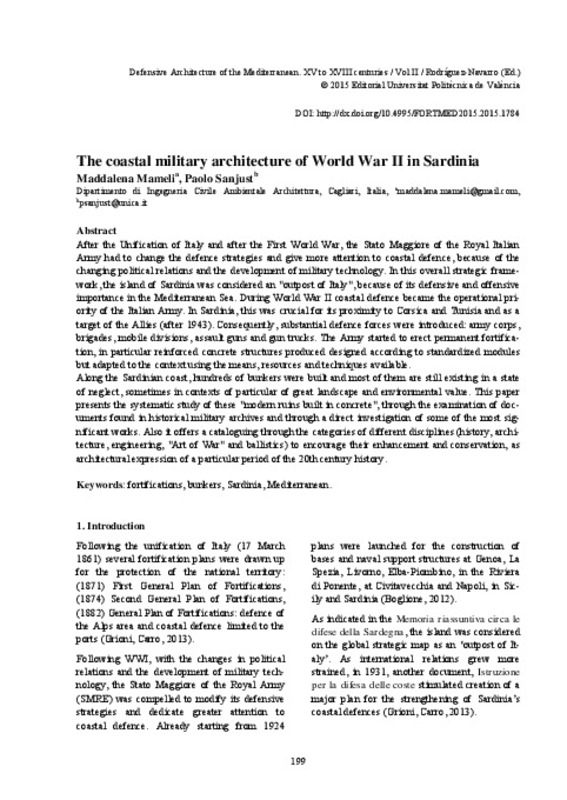JavaScript is disabled for your browser. Some features of this site may not work without it.
Buscar en RiuNet
Listar
Mi cuenta
Estadísticas
Ayuda RiuNet
Admin. UPV
The coastal military architecture of World War II in Sardinia
Mostrar el registro sencillo del ítem
Ficheros en el ítem
| dc.contributor.author | Mameli, Maddalena
|
es_ES |
| dc.contributor.author | Sanjust, Paolo
|
es_ES |
| dc.coverage.spatial | east=9.012892599999986; north=40.1208752; name=Serdenya, Itàlia | |
| dc.date.accessioned | 2018-01-25T10:49:29Z | |
| dc.date.available | 2018-01-25T10:49:29Z | |
| dc.date.issued | 2015-10-16 | |
| dc.identifier.isbn | 9788490483770 | |
| dc.identifier.uri | http://hdl.handle.net/10251/95525 | |
| dc.description.abstract | [EN] After the Unification of Italy and after the First World War, the Stato Maggiore of the Royal Italian Army had to change the defence strategies and give more attention to coastal defence, because of the changing political relations and the development of military technology. In this overall strategic framework, the island of Sardinia was considered an "outpost of Italy", because of its defensive and offensive importance in the Mediterranean Sea. During World War II coastal defence became the operational priority of the Italian Army. In Sardinia, this was crucial for its proximity to Corsica and Tunisia and as a target of the Allies (after 1943). Consequently, substantial defence forces were introduced: army corps, brigades, mobile divisions, assault guns and gun trucks. The Army started to erect permanent fortification, in particular reinforced concrete structures produced designed according to standardized modules but adapted to the context using the means, resources and techniques available. Along the Sardinian coast, hundreds of bunkers were built and most of them are still existing in a state of neglect, sometimes in contexts of particular of great landscape and environmental value. This paper presents the systematic study of these "modern ruins built in concrete", through the examination of documents found in historical military archives and through a direct investigation of some of the most significant works. Also it offers a cataloguing through the categories of different disciplines (history, architecture, engineering, "Art of War" and ballistics) to encourage their enhancement and conservation, as architectural expression of a particular period of the 20th century history. | es_ES |
| dc.format.extent | 8 | es_ES |
| dc.language | Inglés | es_ES |
| dc.publisher | Editorial Universitat Politècnica de València | es_ES |
| dc.relation.ispartof | Defensive architecture of the mediterranean: XV to XVIII centuries. Vol. II | es_ES |
| dc.rights | Reconocimiento - No comercial - Sin obra derivada (by-nc-nd) | es_ES |
| dc.subject | Fortifications | es_ES |
| dc.subject | Mediterranean | es_ES |
| dc.subject | Modern age | es_ES |
| dc.subject | Built Heritage | es_ES |
| dc.subject | Bunkers | es_ES |
| dc.subject | Sardinia | es_ES |
| dc.title | The coastal military architecture of World War II in Sardinia | es_ES |
| dc.type | Capítulo de libro | es_ES |
| dc.type | Comunicación en congreso | es_ES |
| dc.identifier.doi | 10.4995/FORTMED2015.2015.1784 | |
| dc.rights.accessRights | Abierto | es_ES |
| dc.description.bibliographicCitation | Mameli, M.; Sanjust, P. (2015). The coastal military architecture of World War II in Sardinia. En Defensive architecture of the mediterranean: XV to XVIII centuries. Vol. II. Editorial Universitat Politècnica de València. 199-206. https://doi.org/10.4995/FORTMED2015.2015.1784 | es_ES |
| dc.description.accrualMethod | OCS | es_ES |
| dc.relation.conferencename | FORTMED2015 - International Conference on Modern Age Fortifications of the Western Mediterranean coast | es_ES |
| dc.relation.conferencedate | October 15-17,2015 | es_ES |
| dc.relation.conferenceplace | Valencia, Spain | es_ES |
| dc.relation.publisherversion | http://ocs.editorial.upv.es/index.php/FORTMED/FORTMED2015/paper/view/1784 | es_ES |
| dc.description.upvformatpinicio | 199 | es_ES |
| dc.description.upvformatpfin | 206 | es_ES |
| dc.type.version | info:eu-repo/semantics/publishedVersion | es_ES |
| dc.relation.pasarela | OCS\1784 | es_ES |








